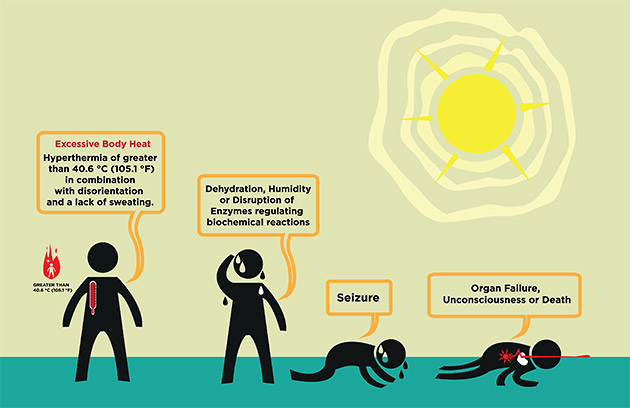3 February, 2020 By: Vanessa Pogorelic
It's the one tragic accident you never imagined you’d have in your car.
During the late 1950s, the US space agency NASA began conducting a series of tests to determine the limits of the human body under a number of extreme conditions - one of them was heat. It included placing astronauts in an enclosed chamber and turning up the temperature.
Although individual responses to extreme heat will vary, at an air temperature greater than 44°C in an environment of high humidity, is it now widely accepted that the human body will be at the very limits of its tolerance.
A daytime temperature greater than 44°C is common in some parts of Western Australia, and while less common in Perth, is always a possibility.
Fortunately, despite our extreme temperatures, it’s not often we have to endure such conditions without some external source to keep us cool, whether it’s air conditioning or even a fan.
But there is one environment you step into almost every day which can create the exact conditions required for fatal hyperthermia. It is the interior of your car – an enclosed, airless metal capsule responsible for many tragic deaths from heat stroke.
What happens to your body when you're trapped in a hot car?
When the balance between the ambient air temperature and your normal body temperature is too far out of balance, your body reacts by trying to bring your temperature down.
One of the ways it does this is by releasing sweat, but inside a hot car there is very little or no circulating air to make sweat an effective way of cooling the body.
“With vehicles, the outside temperature is not always a good gauge of what’s happening inside the car,” says Blaise Rego, Area Manager of Metropolitan Operations at St John Ambulance WA.”
“Within minutes, the temperature inside a locked car can rise significantly.”
Rego explains that for someone trapped in a hot car, as the effects of heatstroke worsen, the body will continue to sweat until it is severely dehydrated and can no longer use this system to cool itself.
“While in the early stage of heatstroke you might see someone sweating, as their condition gets worse, you may not see any sweating at all because the body has gone past that stage. The skin may be dry and hot.
"They will appear weak and could have collapsed or be unconscious.”

In the final stage of heatstroke, your central nervous system will begin to dysfunction, your organs will start to fail and your brain will swell, eventually leading to coma and death.
It is without a doubt a harrowing way to die.
How much time do you have?
Within the first five minutes of closing your car doors, the temperature inside the cabin will increase by as much as 75 per cent.
On a relatively mild 30°C summer day, the temperature inside a car parked in the sun can soar to between 30 and 40°C greater than the outside air - that’s an interior temperature of more than 60°C.
On a 40°C day, the conditions inside your car are so extreme that an adult trapped inside would not survive for long. But for a child, who is even more susceptible to heat stress, hyperthermia and death would occur in an even shorter period of time.
Even at a lower outside air temperature of 30°C, where an adult might find the temperature inside a car parked in the sun uncomfortable, for a baby or small child it can be fatal.
“How long they have varies depending on many things, including the temperature in the car and how much fluid intake they’ve had previously,” Rego says.
“It really is hard to tell how quickly, but children especially will deteriorate very quickly.
“A child just can’t regulate their body temperature as effectively as an adult, so they’ll experience the symptoms a lot quicker than an adult.”
A baby or child also may not show outward signs of distress even when they have been compromised by heat which means heatstroke in a child can sometimes initially go undetected.
Leaving a window slightly open in your car is not enough. University research conducted in WA found that even with a window wound down by 2.5cm to allow some airflow, the inside temperature of a parked car will only reduce by around 3°C – not enough to be safe on a hot or even a warm day.
What about pets?
Animals are also highly susceptible to heat stress. With very few sweat glands to dissipate body heat, animals such as dogs and cats can only rely on panting to help bring their body temperature back into balance.
In a hot car, a dog’s body temperature can rise rapidly resulting in damage to the central nervous system and organ failure. As with babies and small children, the effects of heatstroke on animals may not be apparent until it’s too late.

Even if they survive the heat, they may sustain permanent brain and organ damage. Even after being exposed to temperatures a little over 40°C brain damage is a risk.
Because animals are even more likely than children to be left alone in a car by their owner, it’s important to be aware of just how fragile they are in this environment. Even during rigorous exercise it’s possible for an animal to suffer fatal heatstroke which underlines how at risk they are to heat stress.
How easy it is to get trapped inside a tinder box
Sometimes it can be an error of judgement on the part of a parent or guardian who decides to leave a child or pet unattended in a car while they dash into a shop, but it can also be the result of a split second of absentmindedness.
Each year on average, RAC Roadside Assistance rescues 640 children and pets from cars, where they have been locked inside with the key or remote.
Even in an accidental lock-out where the parent or guardian is present and immediately aware they need to get the child out, acting quickly is essential.
On a warm or hot day, where the temperature could rise rapidly inside the car, call triple zero. The call taker will also be able to give you advice over the phone about what to do before an ambulance arrives.
You should do the same if you spot someone else’s child in a car and they appear to be in distress.
An RAC patrol can also attend in an emergency and you don’t have to be a member to call for this service if the car is yours. But it is important to remember that while lock-outs with children and animals are prioritised, RAC is not an emergency service so is not able to speed to get to the scene or organise medical care once there.
How to treat hyperthermia
If you can manage to get your child out before help arrives, Rego says you should try to give them water if they are able to take it.
“Get them to take small sips regularly. Also take them out of the heated area to somewhere that’s cool and shaded and remove any excess clothing.
“If you’ve got a towel, wet that to keep them sponged down, though don’t try to cool them down too fast and don’t put ice on them. We don’t want them to shiver. If they start to shiver because you’ve tried to cool them too fast, the body will take extra energy to do that.”
Keeping a child in your care safe should be the only reason for never leaving them unattended in a car, but it is also an offence to leave them unsupervised in a car in circumstances where their health may be impacted. The penalty is up to five years imprisonment.
When away from home, keep your car keys on you at all times. Even at home, keep them somewhere safe to prevent a curious child from getting into your car without you knowing. And remember that it’s never okay to leave your child in a locked car.
Highest temperatures ever recorded
Western Australia – 50.5°C Mardie (19 February, 1998)
Australia – 50.7°C Oodnadatta Airport, South Australia (2 January, 1960)
International – 56.7°C Death Valley, California, USA (10 July, 1913)
We rescue 440 WA kids accidentally locked in cars each year
To avoid an accidental lock in, remember to keep your keys on you.
